The pallet stretch wrapping machine market is projected to grow from USD 3.8 billion in 2025 to USD 7.0 billion by 2035, at a CAGR of 6.1%. Expansion is being supported by increasing investment in logistics automation and material handling systems across warehousing facilities, distribution hubs, manufacturing plants, and freight forwarding operations. As highlighted in FMI’s Packaging Innovation Tracker, used by sustainability teams and converters worldwide, the progression from USD 3.8 billion to USD 7.0 billion underscores the accelerating adoption of automated wrapping solutions and advanced load containment technologies across supply chains, e-commerce fulfillment centers, cold storage facilities, and industrial packaging environments.
Between 2025 and 2030, the market is expected to expand from USD 3.8 billion to approximately USD 5.1 billion, generating USD 1.2 billion in additional value and contributing around 39% of the total decade growth. This stage will be defined by widespread adoption of semi-automatic wrapping equipment, as operators focus on labor cost efficiency and improved load stability. Pre-stretch capabilities and electronic control features will transition from premium differentiators to industry standards.
The surge in e-commerce and omnichannel distribution is one of the strongest drivers of demand. As warehouses and fulfillment centers handle higher volumes of outbound shipments, companies are seeking faster and more reliable end-of-line packaging solutions. Stretch wrapping machines ensure that palletized goods are stabilized for transport, preventing damage, reducing returns, and improving overall logistics efficiency. Automated and semi-automatic models are increasingly preferred as businesses focus on labor optimization and consistent wrap quality. With warehouse automation becoming a strategic priority across global supply chains, the integration of advanced pallet wrapping systems is expected to intensify over the coming decade.
The growth of international trade is further boosting the adoption of pallet stretch wrapping machines. Exporters across sectors seek protective packaging solutions that can withstand long-distance transportation and variable climates. Stretch wrapping machines improve container load utilization and protect goods from moisture, dust, and mechanical stress, reducing financial losses and strengthening supply chain resilience. As global freight activity continues to expand, demand for efficient pallet protection systems is expected to increase proportionally.
Technological advancements in machine design are also redefining competitive dynamics. Manufacturers are developing compact, modular, and fully automated systems to accommodate different facility sizes and production volumes. Customizable machine configurations, faster wrapping cycles, and improved safety features are enhancing usability and operational flexibility. Additionally, the growing emphasis on sustainability is encouraging companies to adopt stretch wrapping machines that reduce film waste and enable the use of recyclable materials.
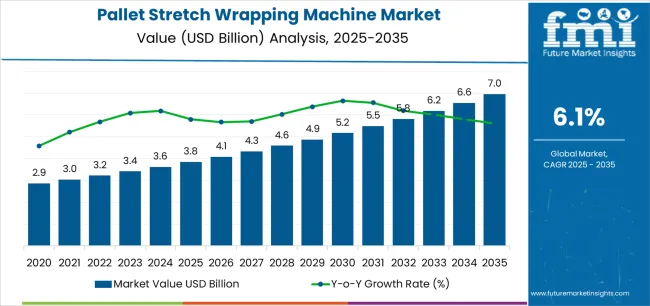
From 2030 to 2035, the market will rise from USD 5.1 billion to USD 7.0 billion, adding USD 1.9 billion in value, which accounts for nearly 61% of decade-long expansion. This period will be characterized by large-scale adoption of fully automatic wrapping systems, integration with warehouse management software, and compatibility with conveyor-driven and robotic palletizing operations. The growth trajectory indicates fundamental changes in pallet securing practices, with manufacturers and logistics providers prioritizing automation-based throughput optimization.
Growth phases present distinct competitive dynamics. Between 2025 and 2030, the market will record steady average growth of 5.7% annually, reflecting a shift from manual wrapping and turntable machines to advanced pre-stretch platforms featuring automated film cutting and pattern controls. Market maturity during this stage is influenced by standardization of pre-stretch ratios, reduced system costs, and warehouse operator awareness of material efficiency benefits that reach 68–74% effectiveness in film savings. Established players such as Lantech and Robopac will continue strengthening automatic wrapping portfolios, while emerging entrants focus on robotic systems and load-sensing enhancements.
From 2030 to 2035, expansion will accelerate with USD 1.9 billion in added value, driven by universal automated wrapping platforms deployed across multiple logistics and industrial settings. Market focus will evolve from load containment strength toward holistic throughput optimization, advanced system compatibility, and integration with Industry 4.0 manufacturing infrastructure, reshaping competitive differentiation.
| Metric | Value |
|---|---|
| Market Value (2025) | USD 3.8 billion |
| Market Forecast (2035) | USD 7 billion |
| Growth Rate | 6.1% CAGR |
| Leading Machine Type | Semi-Automatic Machines |
| Primary End-Use | Food & Beverage Industry |
The market demonstrates strong fundamentals with semi-automatic machine systems capturing a dominant share through superior cost-performance balance and operational flexibility capabilities. Food & beverage applications drive primary demand, supported by increasing cold chain logistics requirements and high-volume packaging operations. Geographic expansion remains concentrated in developed markets with established warehouse automation infrastructure, while emerging economies show accelerating adoption rates driven by e-commerce expansion projects and rising manufacturing production activity.
The pallet stretch wrapping machine market represents a compelling intersection of logistics automation innovation, warehouse efficiency enhancement, and material handling cost management. With robust growth projected from USD 3.8 billion in 2025 to USD 7 billion by 2035 at a 6.10% CAGR, this market is driven by increasing e-commerce fulfillment trends, labor shortage pressures, and commercial demand for film consumption reduction formats.
The market's expansion reflects a fundamental shift in how logistics providers and manufacturing companies approach load securing infrastructure. Strong growth opportunities exist across diverse applications, from distribution center operations requiring high-speed automated wrapping to manufacturing facilities demanding flexible machine configurations. Geographic expansion is particularly pronounced in Asia-Pacific markets, led by China (7.6% CAGR) and India (7.3% CAGR), while established markets in North America and Europe drive innovation and specialized segment development.
The dominance of semi-automatic machine systems and food & beverage applications underscores the importance of proven wrapping efficiency and operational reliability in driving adoption. Equipment integration and film optimization remain key challenges, creating opportunities for companies that can deliver consistent performance while maintaining throughput requirements.
Market expansion rests on three fundamental shifts driving adoption across logistics and manufacturing sectors. Labor efficiency optimization creates compelling advantages through automated wrapping machines that provide comprehensive load securing with minimal operator intervention, enabling warehouse operators to reduce manual wrapping labor costs and enhance worker safety while maintaining load stability assurance and justifying investment over manual stretch film application. E-commerce growth accelerates as fulfillment centers worldwide seek high-throughput wrapping systems that deliver rapid order processing directly to shipping operations, enabling distribution efficiency that aligns with customer delivery expectations and maximizes operational capacity. Film consumption reduction drives adoption from logistics providers requiring optimized pre-stretch equipment that minimizes material usage while maintaining load containment performance during transportation and storage operations.
Growth faces headwinds from equipment investment considerations that differ across machine complexity regarding capital expenditure and operational integration requirements, potentially limiting adoption rates in small-scale warehouse categories. Machine maintenance requirements also persist regarding mechanical component servicing and film carriage adjustments that may increase total ownership costs in facilities with demanding production schedules.
Primary Classification: The market segments by machine type into semi-automatic machines, automatic machines, rotary arm machines, turntable machines, and others categories, representing the evolution from basic manual wrapping operations to advanced integrated automation formats for comprehensive logistics operations.
Secondary Breakdown: End-use industry segmentation divides the market into food & beverage, pharmaceuticals, consumer goods, chemicals, building & construction, and others sectors, reflecting distinct requirements for wrapping speed, load configurations, and operational environments.
Regional Classification: Geographic distribution covers North America, Europe, Asia Pacific, Latin America, and the Middle East & Africa, with developed markets leading technology adoption while emerging economies show accelerating growth patterns driven by warehouse modernization expansion programs.
The segmentation structure reveals technology progression from standard turntable systems toward integrated robotic wrapping platforms with enhanced load sensing and automatic film tension control capabilities, while end-use diversity spans from high-speed beverage distribution operations to manufacturing facilities requiring flexible wrapping configurations and validated load containment solutions.
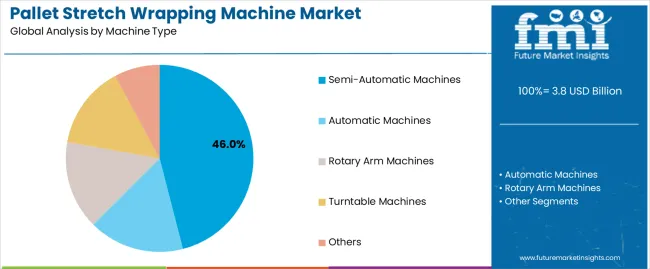
Semi-automatic machines segment is estimated to account for 46% of the pallet stretch wrapping machine market share in 2025. The segment's leading position stems from its fundamental role as a critical component in warehouse wrapping applications and its extensive use across multiple logistics and manufacturing sectors. Semi-automatic machines' dominance is attributed to its superior cost-performance balance, including moderate capital investment, operational flexibility, and operator control capabilities that make it indispensable for medium-volume packaging operations.
Market Position: Semi-automatic wrapping systems command the leading position in the pallet stretch wrapping machine market through proven turntable technologies, including comprehensive speed adjustment, variable wrap pattern selection, and reliable film delivery mechanisms that enable operators to deploy wrapping solutions across diverse warehouse environments.
Value Drivers: The segment benefits from warehouse operator preference for proven equipment configurations that provide exceptional load stability without requiring fully automated conveyor integration. Flexible operation capabilities enable deployment in multi-product facilities, contract packaging operations, and distribution centers where variable load dimensions represent critical handling requirements.
Competitive Advantages: Semi-automatic wrapping systems differentiate through excellent operator accessibility, proven mechanical reliability, and integration with existing warehouse layouts that enhance packaging capabilities while maintaining adjustable wrapping parameters suitable for diverse pallet configurations.
Key market characteristics:
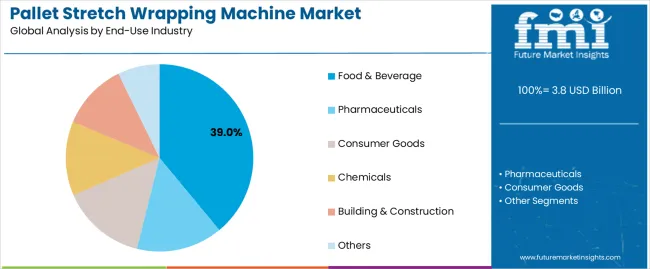
Food & beverage segment is projected to hold 39% of the pallet stretch wrapping machine market share in 2025. The segment's market leadership is driven by the extensive use of stretch wrapping machines in beverage distribution, packaged food operations, frozen product facilities, and fresh produce logistics, where secure load containment serves as both a transportation stability component and product protection element. The food & beverage industry's consistent investment in distribution efficiency solutions supports the segment's dominant position.
Market Context: Food & beverage applications dominate the market due to widespread adoption of high-speed automated wrapping systems and increasing focus on cold chain logistics management, product damage prevention, and hygiene compliance that enhance distribution efficiency while maintaining food safety standards.
Appeal Factors: Food & beverage manufacturers prioritize wrapping speed, consistent load containment, and integration with palletizing equipment that enable coordinated deployment across multiple production facilities. The segment benefits from substantial e-commerce grocery growth and retail distribution requirements that emphasize automated wrapping for beverage and packaged food applications.
Growth Drivers: Cold storage expansion programs incorporate automated wrapping machines as standard protocol for frozen foods and temperature-sensitive products. At the same time, beverage manufacturer initiatives are increasing demand for high-throughput systems that comply with food safety regulations and enhance pallet stability.
Market Challenges: Temperature variation requirements and condensation management concerns may constrain equipment performance in ultra-cold storage facilities or high-humidity packaging scenarios.
Application dynamics include:
Growth Accelerators: E-commerce expansion drives primary adoption as automated wrapping machines provide exceptional throughput capabilities that enable order fulfillment acceleration without manual labor increases, supporting warehouse capacity enhancement and operational efficiency that require integrated equipment formats. Labor shortage pressures accelerate market growth as logistics facilities seek automation solutions that maintain packaging productivity during staffing constraints while enhancing workplace ergonomics through reduced manual material handling. Film optimization opportunities increase worldwide, creating demand for pre-stretch wrapping systems that complement material cost reduction and provide competitive advantages in high-volume distribution.
Growth Inhibitors: Capital investment requirements differ across automation levels regarding equipment complexity and system integration expenses, which may limit market penetration and adoption rates in small warehouse categories with constrained capital budgets. Equipment footprint considerations persist regarding floor space allocation and facility layout modifications that may increase total installation costs in existing distribution centers with limited expansion areas. Market fragmentation across multiple machine configurations and wrapping technologies creates standardization concerns between different logistics providers and existing material handling infrastructure.
Market Evolution Patterns: Adoption accelerates in e-commerce and food & beverage sectors where operational efficiency justifies equipment investments, with geographic concentration in developed markets transitioning toward mainstream adoption in emerging economies driven by warehouse modernization and manufacturing expansion. Technology development focuses on enhanced pre-stretch optimization, improved load sensing mechanisms, and integration with warehouse control systems that optimize wrapping consistency and operational visibility. The market could face disruption if alternative load securing technologies or robotic handling innovations significantly challenge conventional stretch wrapping advantages in logistics applications.
The pallet stretch wrapping machine market demonstrates varied regional dynamics with Growth Leaders including China (7.6% CAGR) and India (7.3% CAGR) driving expansion through manufacturing growth and logistics infrastructure modernization. Steady Performers encompass the USA (6.9% CAGR), Germany (6.1% CAGR), and Japan (5.7% CAGR), benefiting from established e-commerce sectors and warehouse automation innovation.
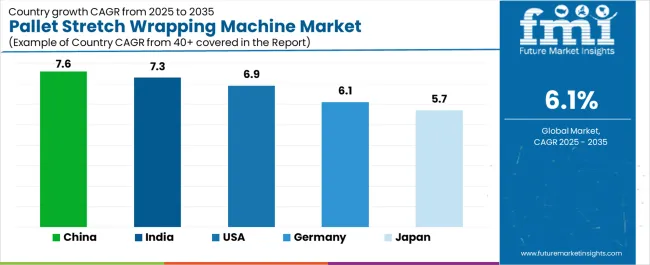
| Country | CAGR (2025-2035) |
|---|---|
| China | 7.6% |
| India | 7.3% |
| USA | 6.9% |
| Germany | 6.1% |
| Japan | 5.7% |
Regional synthesis reveals Asia-Pacific markets leading growth through manufacturing production expansion and e-commerce infrastructure enhancement, while European countries maintain steady expansion supported by specialized cold storage applications and automotive logistics requirements. North American markets show strong growth driven by fulfillment center automation and third-party logistics adoption.
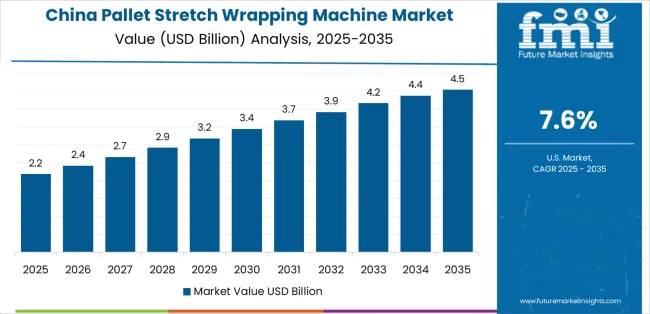
China establishes regional leadership through explosive e-commerce expansion and comprehensive warehouse infrastructure modernization, integrating automated wrapping machines as standard components in distribution centers and manufacturing operations. The country's 7.6% CAGR through 2035 reflects logistics investment growth promoting domestic equipment production and export market activity that mandate the use of automated wrapping systems in packaging operations. Growth concentrates in major logistics hubs, including Guangzhou, Shanghai, and Beijing, where fulfillment facilities showcase integrated automatic wrapping systems that appeal to domestic logistics providers seeking operational efficiency and international service standards.
Chinese equipment manufacturers are developing innovative wrapping solutions that combine local cost advantages with international performance specifications, including advanced pre-stretch capabilities and programmable control features.
Strategic Market Indicators:
The Indian market emphasizes manufacturing applications, including rapid industrial production development and comprehensive logistics infrastructure that increasingly incorporates semi-automatic wrapping machines for packaged goods and construction material applications. The country is projected to show a 7.3% CAGR through 2035, driven by massive warehouse construction activity under government infrastructure initiatives and commercial demand for affordable, reliable wrapping systems. Indian logistics operators prioritize cost-effectiveness with semi-automatic machines delivering operational efficiency through economical equipment specifications and flexible operation capabilities.
Technology deployment channels include third-party logistics providers, manufacturing facilities, and distribution centers that support high-volume usage for domestic and regional markets.
Performance Metrics:
The USA market emphasizes advanced automated wrapping features, including innovative robotic wrapping integration and comprehensive warehouse management system connectivity that manage throughput optimization, film consumption tracking, and performance monitoring applications through unified automation platforms. The country is projected to show a 6.9% CAGR through 2035, driven by e-commerce fulfillment innovation under omnichannel retail trends and commercial demand for high-speed, intelligent wrapping systems. American logistics companies prioritize operational efficiency with automated wrapping delivering comprehensive productivity enhancement through advanced control technology and proven load stability.
Technology deployment channels include major e-commerce fulfillment centers, third-party logistics operators, and food distribution facilities that support custom configurations for specialized operations.
Performance Metrics:
In Stuttgart, Munich, and Hamburg, German automotive manufacturers and industrial logistics companies are implementing advanced wrapping systems to enhance load securing capabilities and support operational efficiency that aligns with Industry 4.0 protocols and lean manufacturing standards. The German market demonstrates growth with a 6.1% CAGR through 2035, driven by automotive parts logistics programs and manufacturing investments that emphasize automated wrapping systems for export shipment and just-in-time applications. German logistics facilities are prioritizing wrapping machines that provide exceptional load consistency while maintaining integration with conveyor systems and minimizing cycle times, particularly important in automotive component distribution and chemical product shipping operations.
Market expansion benefits from warehouse automation programs that mandate integrated wrapping in logistics specifications, creating demand across Germany's manufacturing and distribution sectors, where throughput excellence and equipment reliability represent critical requirements.
Strategic Market Indicators:
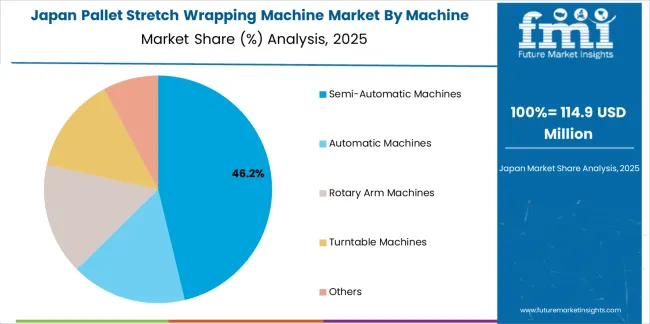
The sophisticated manufacturing market in Japan demonstrates meticulous wrapping machine deployment, growing at 5.7% CAGR, with documented operational excellence in automotive parts logistics and electronics component packaging applications through integration with existing production systems and quality control infrastructure. The country leverages engineering expertise in mechatronics and automation technology to maintain market leadership. Manufacturing centers, including Tokyo, Osaka, and Nagoya, showcase advanced installations where automated wrapping machines integrate with comprehensive robotic palletizing platforms and warehouse control systems to optimize load stability and operational efficiency.
Japanese logistics operators prioritize wrapping precision and equipment durability in facility planning, creating demand for premium automatic machines with advanced features, including variable speed control and integration with factory automation protocols. The market benefits from established manufacturing infrastructure and willingness to invest in specialized wrapping technologies that provide superior load containment and operational monitoring.
Market Intelligence Brief:
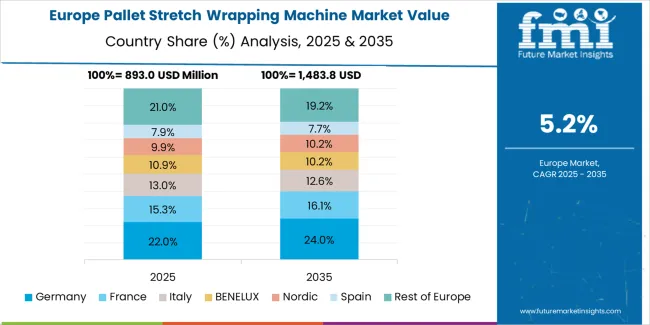
The pallet stretch wrapping machine market in Europe is projected to grow from USD 1,016 million in 2025 to USD 1,709 million by 2035, registering a CAGR of 5.3% over the forecast period. Germany is expected to maintain its leadership position with a 33.8% market share in 2025, declining slightly to 33.2% by 2035, supported by its automotive logistics excellence and major manufacturing centers, including North Rhine-Westphalia and Bavaria.
France follows with a 26.4% share in 2025, projected to reach 26.9% by 2035, driven by comprehensive food distribution operations and retail logistics initiatives. The United Kingdom holds a 19.7% share in 2025, expected to maintain 20.3% by 2035 through established e-commerce sectors and third-party logistics adoption. Italy commands an 11.6% share, while Spain accounts for 6.8% in 2025. The Rest of Europe region is anticipated to gain momentum, expanding its collective share from 1.7% to 2.1% by 2035, attributed to increasing warehouse automation in Eastern European countries and emerging Scandinavian logistics companies implementing automated wrapping programs.
The pallet stretch wrapping machine market operates with moderate concentration, featuring approximately 35-42 participants, where leading companies control roughly 38-44% of the global market share through established logistics customer networks and comprehensive equipment manufacturing capabilities. Competition emphasizes wrapping speed, film optimization, and equipment reliability rather than price-based rivalry.
Market leaders encompass Lantech, Robopac, and FROMM, which maintain competitive advantages through extensive packaging equipment expertise, global service networks, and comprehensive application engineering capabilities that create logistics provider loyalty and support operational requirements. These companies leverage decades of material handling experience and ongoing automation investments to develop advanced wrapping machines with exceptional load containment and throughput optimization features.
Specialty challengers include Atlanta Stretch, Signode, and Muller LCS, which compete through specialized technology innovation focus and efficient integration solutions that appeal to fulfillment operations seeking advanced control systems and custom equipment configurations. These companies differentiate through mechatronics engineering emphasis and specialized application focus.
Market dynamics favor participants that combine reliable wrapping performance with advanced technical support, including installation services and operator training capabilities. Competitive pressure intensifies as traditional packaging equipment manufacturers expand into robotic wrapping systems. At the same time, specialized automation suppliers challenge established players through innovative load sensing technology and cost-effective solutions targeting emerging e-commerce segments.
| Item | Value |
|---|---|
| Quantitative Units | USD 3.8 billion |
| Machine Type | Semi-Automatic Machines, Automatic Machines, Rotary Arm Machines, Turntable Machines, Others |
| End-Use Industry | Food & Beverage, Pharmaceuticals, Consumer Goods, Chemicals, Building & Construction, Others |
| Regions Covered | North America, Europe, Asia Pacific, Latin America, Middle East & Africa |
| Countries Covered | USA, Germany, Japan, China, India, and 25+ additional countries |
| Key Companies Profiled | Lantech, Robopac, FROMM, Atlanta Stretch, Signode, Muller LCS |
| Additional Attributes | Dollar sales by machine type and end-use industry categories, regional adoption trends across North America, Europe, and Asia-Pacific, competitive landscape with packaging equipment companies and automation suppliers, logistics operator preferences for wrapping speed and film optimization, integration with conveyor systems and robotic palletizing equipment, innovations in pre-stretch technology and load sensing mechanisms, and development of specialized e-commerce solutions with enhanced throughput capabilities and validated load containment features |
The global pallet stretch wrapping machine market is estimated to be valued at USD 3.8 billion in 2025.
The market size for the pallet stretch wrapping machine market is projected to reach USD 7.0 billion by 2035.
The pallet stretch wrapping machine market is expected to grow at a 6.1% CAGR between 2025 and 2035.
The key product types in pallet stretch wrapping machine market are semi-automatic machines , automatic machines, rotary arm machines, turntable machines and others.
In terms of end-use industry, food & beverage segment to command 39.0% share in the pallet stretch wrapping machine market in 2025.






Our Research Products

The "Full Research Suite" delivers actionable market intel, deep dives on markets or technologies, so clients act faster, cut risk, and unlock growth.

The Leaderboard benchmarks and ranks top vendors, classifying them as Established Leaders, Leading Challengers, or Disruptors & Challengers.

Locates where complements amplify value and substitutes erode it, forecasting net impact by horizon

We deliver granular, decision-grade intel: market sizing, 5-year forecasts, pricing, adoption, usage, revenue, and operational KPIs—plus competitor tracking, regulation, and value chains—across 60 countries broadly.

Spot the shifts before they hit your P&L. We track inflection points, adoption curves, pricing moves, and ecosystem plays to show where demand is heading, why it is changing, and what to do next across high-growth markets and disruptive tech

Real-time reads of user behavior. We track shifting priorities, perceptions of today’s and next-gen services, and provider experience, then pace how fast tech moves from trial to adoption, blending buyer, consumer, and channel inputs with social signals (#WhySwitch, #UX).

Partner with our analyst team to build a custom report designed around your business priorities. From analysing market trends to assessing competitors or crafting bespoke datasets, we tailor insights to your needs.
Supplier Intelligence
Discovery & Profiling
Capacity & Footprint
Performance & Risk
Compliance & Governance
Commercial Readiness
Who Supplies Whom
Scorecards & Shortlists
Playbooks & Docs
Category Intelligence
Definition & Scope
Demand & Use Cases
Cost Drivers
Market Structure
Supply Chain Map
Trade & Policy
Operating Norms
Deliverables
Buyer Intelligence
Account Basics
Spend & Scope
Procurement Model
Vendor Requirements
Terms & Policies
Entry Strategy
Pain Points & Triggers
Outputs
Pricing Analysis
Benchmarks
Trends
Should-Cost
Indexation
Landed Cost
Commercial Terms
Deliverables
Brand Analysis
Positioning & Value Prop
Share & Presence
Customer Evidence
Go-to-Market
Digital & Reputation
Compliance & Trust
KPIs & Gaps
Outputs
Full Research Suite comprises of:
Market outlook & trends analysis
Interviews & case studies
Strategic recommendations
Vendor profiles & capabilities analysis
5-year forecasts
8 regions and 60+ country-level data splits
Market segment data splits
12 months of continuous data updates
DELIVERED AS:
PDF EXCEL ONLINE
Market Share Breakdown of Pallet Stretch Wrapping Machine Manufacturers
Stretch Hood Pallet Wrapping Market
Wrapping Machines for Handkerchiefs Market Size and Share Forecast Outlook 2025 to 2035
Wrapping Machine Market
Palletizing Machines Market Growth & Demand 2025 to 2035
Pallet Banding Machine Market Analysis - Growth & Forecast 2025 to 2035
Overwrapping Machines Market Size and Share Forecast Outlook 2025 to 2035
Market Share Distribution Among Overwrapping Machine Manufacturers
Pallet Strapping Machines Market
Pipe Wrapping Machines Market
Stretch Blow Molding Machines Market Segmentation based on Technology Type, Orientation Type, End Use, and Region: A Forecast for 2025 and 2035
Market Share Insights of Leading Stretch Blow Molding Machines Providers
Candy Wrapping Machine Market
Wrapping and Bundling Machines Market Size and Share Forecast Outlook 2025 to 2035
Shrink Wrapping Machines Market Size and Share Forecast Outlook 2025 to 2035
Market Share Insights for Shrink Wrapping Machines Providers
Sleeve Wrapping Machine Market
Shrink Wrapping Machine Market
PET Stretch Blow Molding Machines Market Size and Share Forecast Outlook 2025 to 2035
Chocolate Wrapping Machine Market Size and Share Forecast Outlook 2025 to 2035

Thank you!
You will receive an email from our Business Development Manager. Please be sure to check your SPAM/JUNK folder too.
Chat With
MaRIA